Decoys and Calling
Decoying Canada Geese
By B.C. Maxima
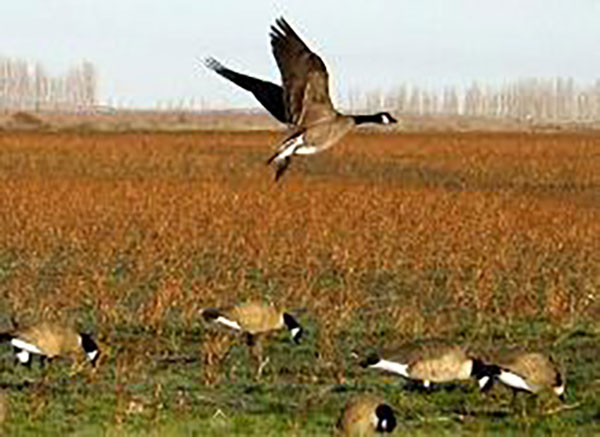
A Five Part Mini-Series
- Overview: What It Takes To Be Successful
- Location: Finding the Perfect Field
- Concealment: Get Down And Cover Up
- Decoys and Calling: The Hard Facts
- The Hunt: Tying It Together
Part 4 Decoys and Calling: The hard facts!
One sure way for you to double check how effective your current decoy spread is to leave the decoys up, walk away from the spread, and watch what happens. If the next flock that comes in flares at 50 yards even when you are gone, then a red flag should come up and you may have to make some adjustments to your spread!
In this article we will conduct a thorough evaluation of several types of decoys, we will discuss how to add movement and realism into your existing spread, and we will share with you some different ideas on how to set up your decoy spread. As a supplement to this article, we will also add an additional section for those of you who would like more information on “Calling Geese” and why it is so important to know how and when to use a quality goose call. This area will be located in the conclusion of this article.
DECOY REVIEW AND EVALUATION
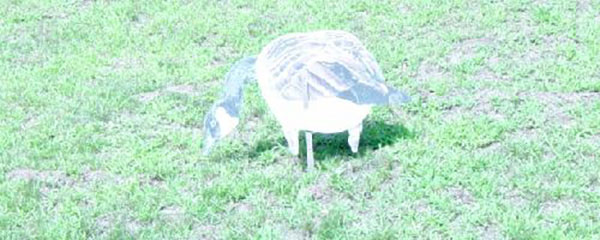
Every decoy made was designed for a purpose. Even those old Flambeau floaters have some value. As ridiculous as they look on the shelf, if placed in a line spaced out approximately five yards apart outside of your main flock, they do simulate a small flock swimming into your main spread. The most important thing is to keep your spread uniform! The mosh posh decoy spread does not work! Try and use one or two types of decoys that match well together in an attempt to duplicate an actual flock of geese as closely as possible.
Silhouette decoys can be very effective in certain situations. If set up correctly, a large spread of silhouettes can be deadly, especially in those hard to access areas. The two main problems I see with these manufactured silhouette decoys are: most of the finishes on these decoys glare terribly in the sun so keep them in the trailer on those really nice days! As much as they state Non Glare Finish on the box, watch your next hunting video very closely and see what happens when the sun comes up in the spread. Therefore, I recommend making your own silhouettes. They may not look as pretty as the store bought decoys but if you spend the time they can actually work better. The next problem is that they are usually set up improperly. We will address this issue later in the article.
The next decoy type we will review are those good old shell decoys. These are probably the most popular goose decoys on the market today or at least they were five years ago. Although, I still have a couple dozen I only use them in certain situations. For the most part, these decoys are becoming outdated as the geese are getting smarter and smarter each year. I feel that the Super Duper Magnum Shells that worked well 15 years ago, do not have the impact they did before the geese caught onto them.
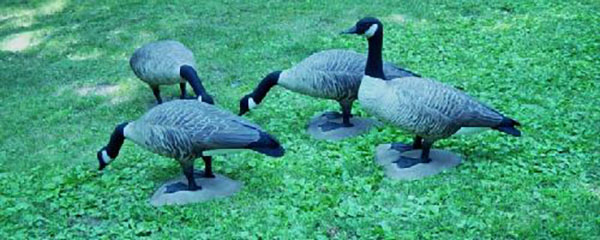
I do however like to mix in a couple dozen regular magnum G and H shells with my full body spread as these particular decoys mix in well to add bulk as well as realism during the colder months. If you are looking to add some shells to your spread, I also recommend looking for used decoys instead of paying full price for them since they are not cheap and almost every goose hunter has a couple dozen in the garage somewhere.
The latest in goose hunting technology is the Full Body Canada Goose Decoy! This product is becoming more and more popular and expensive as time goes on. Who would have thought that a goose hunter would pay 50 dollars per decoy and proceed to buy dozens of them! I believe there are over ten types of Full Body manufactures on the market today. I still think that the Big Foot decoy is the ultimate goose decoy. It is the most durable decoy ever invented, it is competitively priced, and it actually looks like a goose. I also like the fact that the legs can be removed to add realism as well as the fact that most every product made to add movement to your decoys is made for the Big Foot decoy. The new Avery full bodies are very nice as well.
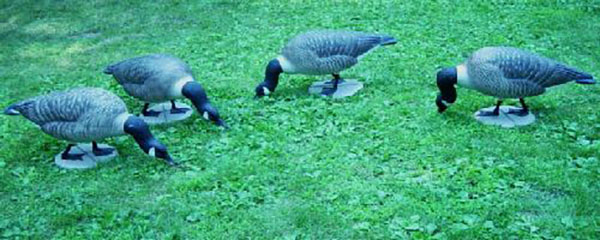
They are very reasonably priced and look even better than the Big Foots but they are not as durable and may blow over in a heavy wind. It is also much harder to add movement to this particular spread of decoys compared to the Big Foots. As for the other full body manufacturers in the $25.00 range, I would not develop a complete spread with their decoys but do like to utilize a couple of the different head positions into my existing spread. Lastly are the high end full bodies, these include decoys like the Hardcore’s, the Dave Smith‘s and the Dropzone Elite decoys.
They all look great, but are they worth the money? Well lets examine what they offer. They all need to be put into bags to keep the paint jobs looking good, most of them are a 3 piece system which adds to set up time and most of them are not as durable. I do recommend adding a dozen or two to your arsenal if you can afford it for those days when your massive full body spread isn’t working (late season) or when you are hunting alone and would rather try a distinct spread instead of a massive one.
As for Stuffers- which are actual stuffed geese, I believe these are best used in high end goose camps and are more for show than anything else. For the average or die-hard goose hunter who hunts in elements when the goose hunting is best, these decoys will not hold up, they take way too much time to make and if you are looking for the ultimate in realism, those decoys are now available in plastic models as discussed above. Most importantly however, they are not legal in many states.
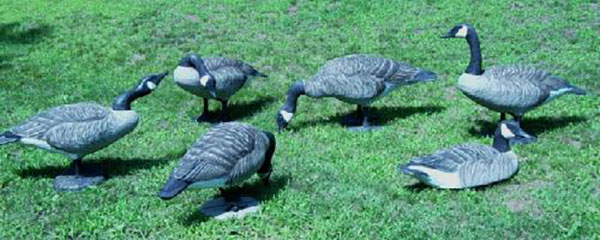
The last type of decoy we will discuss is the Floater Goose Decoy. Again I believe that Big Foot has the best product on the market. One aspect I particularly like is the fact that they are very versatile and can be used with your full body Big Foots in the field as well. They are not too expensive, they are almost as durable as their full bodies and with four different head positions, I think they look better than any other floater on the market! Avery has come out with a close second. They are a little cheaper than the Big Foots and they offer a nice selection of head positions as well. One nice thing about the Avery decoys is that the heads are pre-flocked which is nice. G and H offers a nice decoy but their heads are broken easily and for the price, I would go with one of the two mentioned above.
ADDING MOVEMENT AND REALISM

Why is movement so vital to your spread? Your traditional spread may work well during the early Canada goose season… for the first weekend but as the geese get hunted they catch on to the Frozen Soldier spread quickly! There are however several simple and cheap ways to add movement and realism to your existing goose spread. The most effective method of adding movement to your spread is “Flagging”. This technique was invented by Randy Bartz in the early 90’s and can be as effective as calling to attract geese to your spread.
It is so popular that most every quality layout blind comes equipped with a flagging hole. My favorite new product on the market is the Bobble head. This is a wind activated product designed to fit onto your Big Foot goose decoy. The heads come pre-flocked and the slightest bit of wind will get them moving. A dozen of these heads at $5.00 a piece can really add life to your spread. Another new product is the Power Base. This product is battery activated and attaches to the base of your decoy to get it moving. The only problem is that they are expensive and set up can be frustrating in the dark. The cost is $100.00 for a pair which may be over budget for some hunters. The Decoy Dancer just came out this year as an alternative. This product is wind activated and has several settings for different wind speeds. It is pre-set so there is minimal work in the morning. They are $15.00 a piece or $168.00 for a dozen. At this time they do only fit on Big Foots decoys though. This is a new product therefore unproven but in theory this looks like a great idea.
The Wing Waver is also a nice product. This is a flapper decoy that is run off of a string which the hunter can pull when movement is needed. This product is nice because it takes the movement away from the hunter. They are $70.00 a piece but are very durable and should last a long time. The only downfall to this product is that it is manual therefore making it hard to call and operate at the same time. As for “Spinning Wing Decoys” and goose hunting, they don’t mix! As productive as the spinning wing decoys are for duck hunting, they as equally as unproductive for the goose hunter. My recommendation is to use your spinning wing decoy early in the morning when the Mallards are flying (if you believe in the use of them) and then take it down as soon as the first flocks of geese start flying.
Now let us get into adding more realism into your goose spread. The first thing we can do is flock the heads of our decoys. This works great and can be done fairly cheap. I recommend speaking with a local taxidermist about purchasing flocking by the pound before I would buy the kits at $35.00 a piece in the store. There are also several companies that specialize in professional flocking for close to the same price as it would be to buy the kit at retail price. Adding flocking to the butt of your decoy also adds additional realism to an already productive spread. As for flocking durability, if it is done right you can expect to get three seasons of hunting before they need to be touched up depending on how well they have been cared for. Now for the die-hard goose hunter, one way to use your existing spread and retain the new look of the high-end full-body decoys is to get your spread custom painted. This really works well to add realism while incorporating several different full-body manufacture designs into one uniform color scheme. Paddles Down Custom Decoy Painting charges $100.00 a dozen and does an excellent job!
SETTING UP YOUR SPREAD
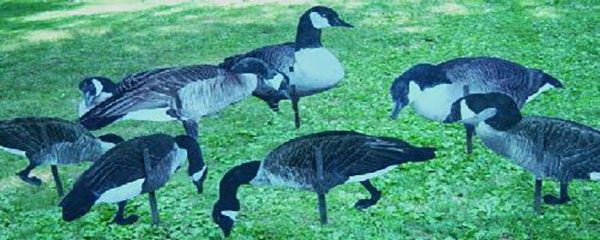
As a rule of thumb, I like to use two dozen decoys per hunter. That number can change depending on the hunting pressure and number of birds in the area. In the early season, three guys can get away with a spread of twenty or thirty decoys while during the late season birds are flocked up in the hundreds you may need a bigger spread to draw attention as well as to hide the hunters from wary birds. Depending on the type of spread you are using, there are many different ways to set up your spread.
Let’s start with a walk in field or hard to reach area where we need to carry in our spread. In this situation, a backpack layout blind and a spread of silhouettes is our best bet. The problem here is that most hunters set up there silhouettes as if they were regular decoys five yards apart in a half moon design. That works fine until the geese get overhead and all of a sudden your decoy spread disappears. During the first two months of hunting season especially, I like to set my spread of silhouettes up in small tight family groups of a dozen decoys facing every which way, each group set 15 to 20 yards apart over a 75 yard span. This way when the geese come in, they are seeing decoys throughout the completion of their approach. Another nice feature of the silhouette design is that as the geese approach we have built in movement because these decoys are constantly disappearing and reappearing at different angles.
Now let’s hunt over water with our floater spread. I like to place the spread close to shore, off of an open shoreline or sandbar area that I know the geese are using. Another tactic for silhouettes is to place three or four dozen on the shore in conjunction with a water spread. They are a nice and compact decoy spread to fit into an already overloaded duck boat.
For a more traditional set up where we can drive into a field with a trailer full of full bodies and shell decoys; an early season set up again can allow for a set up of small family groups spaced out every 15 to 20 yards. With an effective caller and some flagging, we do not need to worry about geese landing out of range like we do while duck hunting. As the season progresses and they start to stage up into larger flocks, the number of decoys needs to increase. However, we also need to start being more creative than the old stand by half moon set up. On a windy day if you watch a real flock of geese, you will notice that they all line up vertically into the wind. We can try and emulate that while placing a smaller group of decoys off to the side to hide additional hunters in the spread. As the season grows colder you will notice that a lot of times the geese will curl up on the ground instead of standing up to conserve energy. This is when I like to remove the feet on the Big Foots or add shell decoys and floaters.
In conclusion, there are many new decoys coming out every year and they keep getting better each year. Do we need to buy the most expensive decoys on the market… probably not but washing off your old decoys and adding a fresh coat of paint once in a while is well worth the effort. If the birds in your area are getting stale, don’t be afraid to try new things. We need to get creative and think outside the box. Maybe a late season set up on an iced over lake with two dozen full bodies directly in a flight path is just the ticket. If everybody in the area has been hunting with spreads of 100+ decoys, try one dozen decoys in a field that is close to the main flock and don’t be surprised to see a couple smaller flocks drop in to your mini spread. Take some time to actually watch a flock of birds and see how they actually sit and what calls they make in different situations. It will be an education that can be used for many years to come. For additional information on Calling Canada Geese click here.
Additional Tips From The Pro’s Articles
- Decoying And Calling: The Hard Facts!
- Decoying Canada Geese – Decoying Canada Geese
- Retrievers & Chiropractic – Can An Animal Chiropractor Help?
- Retriever Performance Events And Why You Should Care
- The Scent Control Debate
- Ten Tips For A More Successful Pheasant Hunt
- Wanton Waste Laws – What Do They Mean & Why Do They Exist?
- How To Get Started Bow Hunting
- The Perfect Deer Rifle
- Exercise Induced Collapse (EIC) In Retrievers – Hunters Beware!
- A Guide To Tipping Your Guide
- Are Canada Geese Actually Getting Smarter Each Fall?
- Top 5 Criteria To Look For in A Fishing Report
- How High Is Too High?
- Turkey Hunting Tips And Tactics
- Realistic Expectations For A Quality Guided Spring Snow Goose Hunt
- Conditioning Your Retriever For The Upcoming Season
